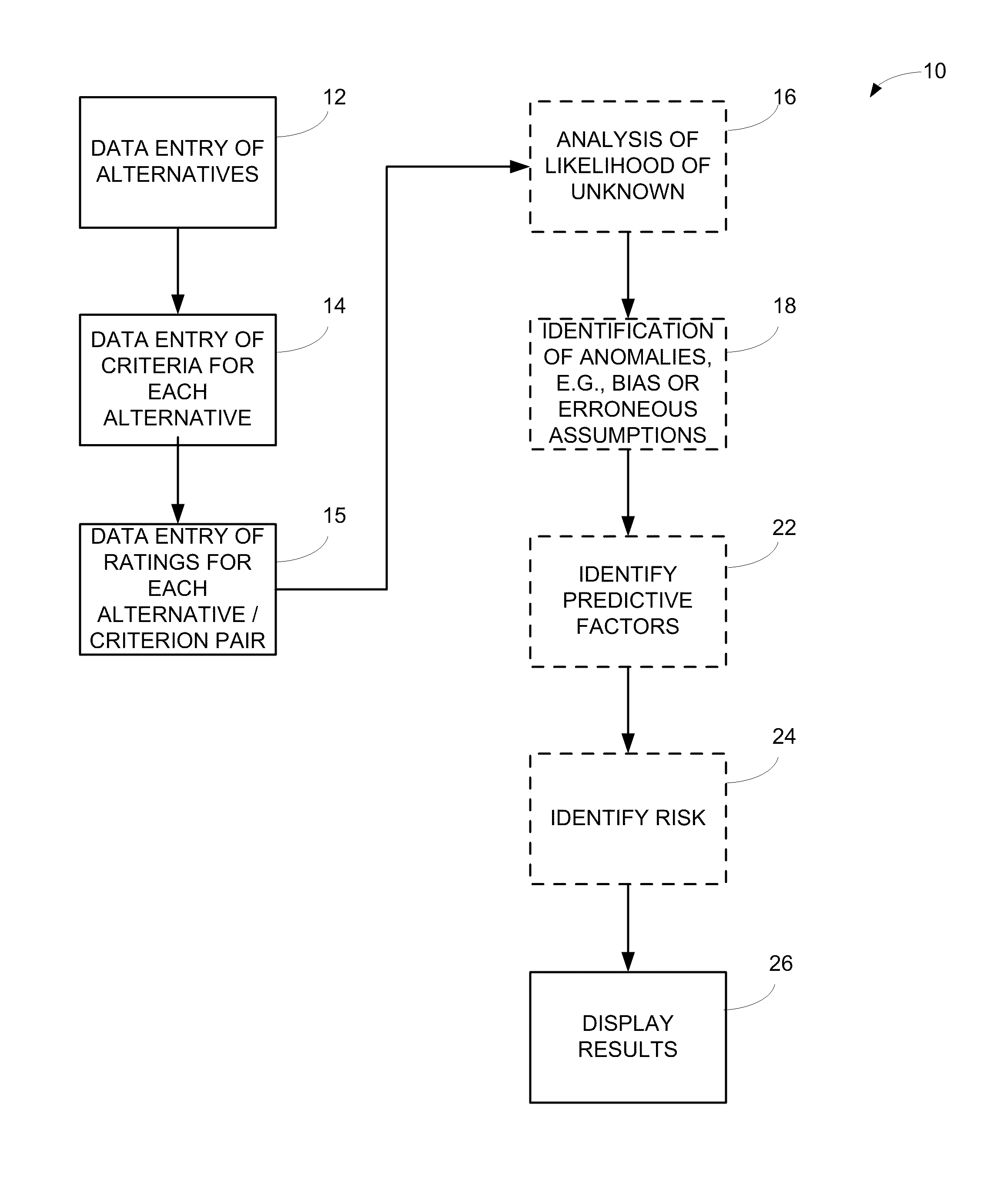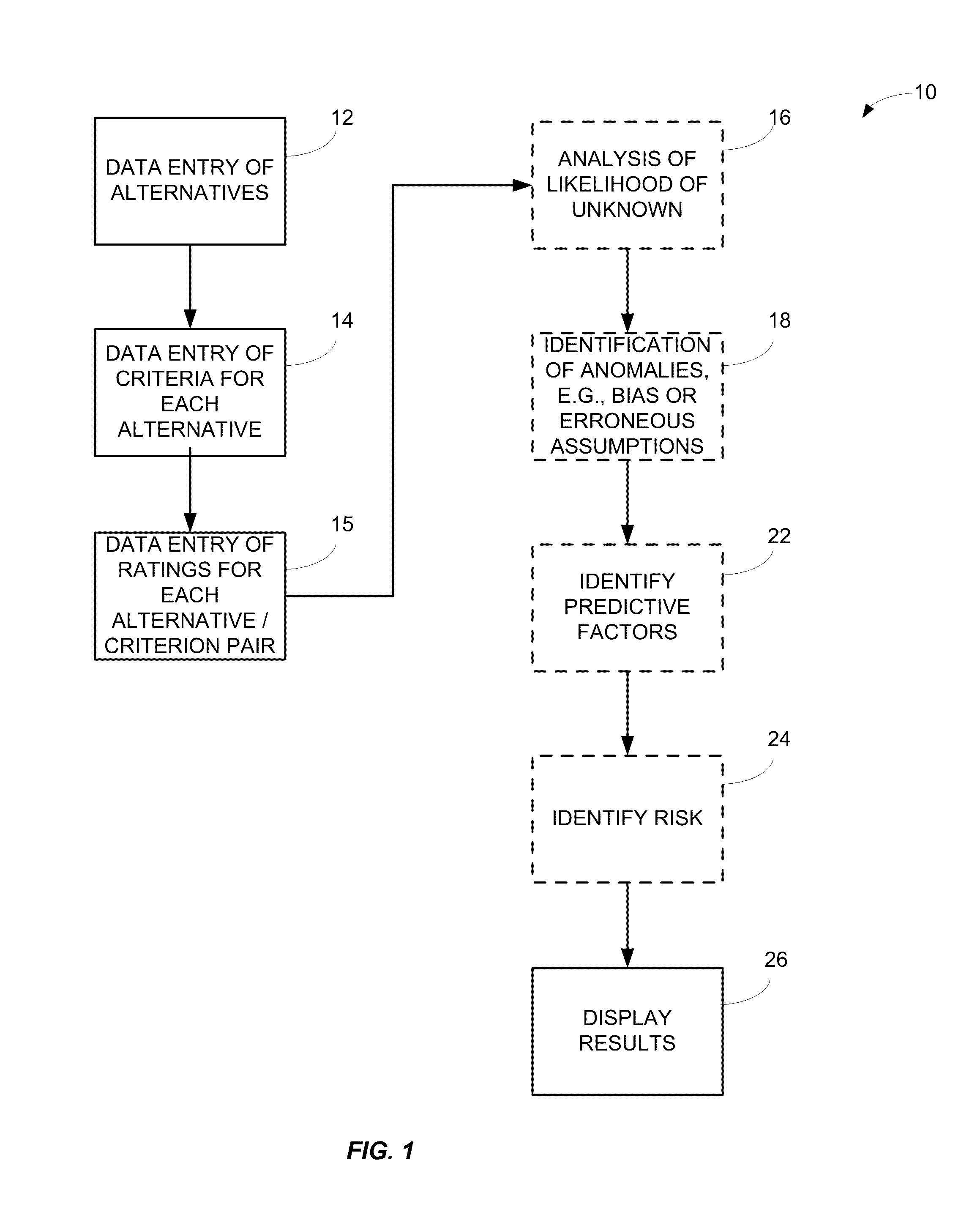System and method for making decisions
a decision-making system and decision-making technology, applied in the field of decision-making and analysis, can solve problems such as difficult and impacted selection of correct action or decision, dangerous problems, and perennial problems of surpris
- Summary
- Abstract
- Description
- Claims
- Application Information
AI Technical Summary
Benefits of technology
Problems solved by technology
Method used
Image
Examples
example 1
Error Increase
[0190]In this example, which is indicative of prior systems, the revenue in a business is 100 (in millions of dollars). The costs are 95. Hence, profits are 5.
[0191]
Revenue =100Costs =95Profit =5
[0192]But in this example there are a variety of problems so there is an estimated 10% error in the revenue figure. The real revenue, thus, is anything from 90 to 110. For simplicity, it is first assumed the costs remain at 95. Now the problem becomes
[0193]
Revenue =[90 to 110]Costs =95Profit =[−5 to 15]
[0194]Originally, the profit was believed to be 5, but due to the error in the input information, it could be from −5 to 15. In other words, due to the procedure employed, an input error of 10% balloons to a perhaps 200% output error. The elasticity here is inordinately large since this is a very large increase.
example 2
Better Algorithm
[0195]A different procedure might treat the errors in a superior manner. To illustrate, in this example there are 60 white balls and 30 red balls. Thus the percentage of white balls is 66⅔%:
[0196]6060+30
[0197]Now it is assumed that an error has been discovered. There were not 60 white balls, but 70. This is a 16⅔% error in the input (10 on a base of 60).
[0198]The correct result is thus 70% white balls:
[0199]7070+30
[0200]Previously it was believed that the percentage of white balls was 66⅔ when it really was 70. That is an error of 5% in the output (3⅓ on a base of 66⅔).
[0201]The input data was in error by 16⅔%. However, the final result, the output, was in error only 5%. In other words, the input error of 16⅔% has been reduced to 5%, less than ⅓ as large.
[0202]The two different example procedures above treated the errors quite differently: one vastly increased the error while the other reduced it. It is a matter of the elasticity. In designing an algorithm there are ...
example 3
[0205]FIG. 13 depicts a decision about acquiring a firm in India. Along the top in blue (at arrow 1), the different alternatives are listed. Along the left side in yellow (at arrow 2), are the criteria that are employed to select the best alternative. In the column at the right side of the yellow (at arrow 3), are provided the weights of the importance of each criterion factors, in this case they range from Low, Medium to High.
[0206]At arrow 4 is a large white group of cells with plus and minus ratings. Blank cells default to neutral. These cells depict how each alternative rated on each criteria. Across a row are the ratings given the different alternatives for the specific criterion or factor. For example, the possibility “Acquire 100% of Indian Firm” received a double plus on the factor “Immediate growth with revenues likely doubling”. Also along the top in blue are cigarette-like bars and corresponding numbers (see arrow 5). The numbers are the probability that the corresponding...
PUM
 Login to View More
Login to View More Abstract
Description
Claims
Application Information
 Login to View More
Login to View More - R&D
- Intellectual Property
- Life Sciences
- Materials
- Tech Scout
- Unparalleled Data Quality
- Higher Quality Content
- 60% Fewer Hallucinations
Browse by: Latest US Patents, China's latest patents, Technical Efficacy Thesaurus, Application Domain, Technology Topic, Popular Technical Reports.
© 2025 PatSnap. All rights reserved.Legal|Privacy policy|Modern Slavery Act Transparency Statement|Sitemap|About US| Contact US: help@patsnap.com



